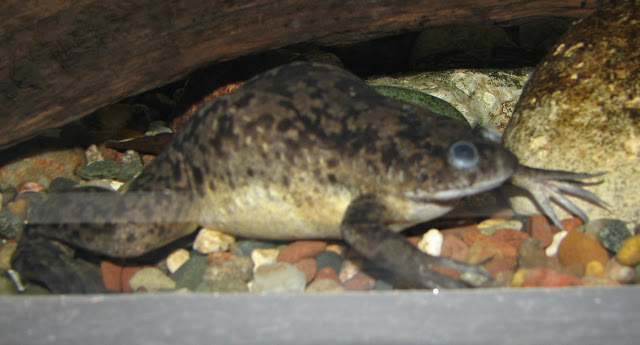
African clawed frog may be a species of frog that's found in eastern and southern parts of Africa. African clawed frogs aren't listed as species , but they're very sensitive to the pollution of the water.
Quick Facts
| Common Name | African Clawed Frog |
| Scientific Name | Xenopus laevis |
| Group | Amphibian |
| Location | Eastern and southern Africa |
| Habitat | Warm stagnant water with grassland |
| Colour | Brown, Grey, Albino |
| Size (L) | 2.5cm - 12cm (1in - 5in) |
| Weight | 25g - 220g (1oz - 8oz) |
| Top Speed | 8km/h (5mph) |
| Diet | Carnivore |
| Prey | Small Fish, Insects, Spiders |
| Predators | Snakes, Birds, Small Mammals |
| Lifestyle | Nocturnal |
| Lifespan | 8 - 15 years |
| Age of Sexual Maturity | 10 - 12 months |
African Clawed Frog Anatomy and Appearance
The average adult African Clawed Frog grows to about 12 cm long , and weighs around 200g. The African Clawed Frog is usually a greenish, grey colour although other colours of the African Clawed Frog aren't uncommon (such as albino). The colour of the African Clawed Frog's skin, along side its mottled pattern, gives it more camouflage from hungry predators. They have a line of stitch-marks along either side of their bodies which act as sense organs to detect prey within the surrounding water. Their eyes and nose are located on top of the top enabling them to ascertain and breathe but without being too visible.African Clawed Frog Reproduction and Life Cycles
Female African Clawed Frogs are often nearly double the dimensions of the males, and are ready to reproduce quite once a year. After mating, the feminine African Clawed Frog can lay thousands of eggs at a time on an underwater object, which are held together within the water by a jelly-like substance. After hatching, the African Clawed Frog tadpoles begin their life within the water until they grow legs and are ready to venture out onto the river banks if need be.The African Clawed Frog is understood to possess an extended lifespan for little aquatic animals, and may live to around 5 to fifteen years within the wild. Some adult African Clawed Frogs are recorded to measure to just about 30 years old in captivity.
African Clawed Frog Behaviour and Lifestyle
The African Clawed Frog spends its whole life in water, apart from poking its head to the surface from time to time to breathe. The African Clawed Frog can swim at astonishing speeds sideways, backwards, forwards, up and down, and altogether other directions. It is a ferocious predator and once food has been spotted, the African Clawed Frog then catches its prey using its claws, which shovel it into the African Clawed Frog's mouth.The African Clawed Frog has evolved very successfully as a bottom-dwelling animal, which suggests that it's greater protection from predators and a far better choice of food.
African Clawed Frog Distribution and Habitat
The African Clawed Frog is most ordinarily found in eastern and southern Africa, along the African valley where they like stagnant waters to fast-flowing streams. African Clawed Frogs are bottom-dwelling animals and can only leave the security of the water if they're forced to migrate.They inhabit warm shallow creeks and rivers during the summer and enter the flooded forests during the season. Due to introduction by Humans, the African Clawed Frog can now be found in numerous freshwater habitats outside of Africa where they will be a really invasive species.
African Clawed Frog Interesting Facts and Features
The African Clawed Frog is known as for his or her unique feet, as their hind feet are webbed but their front legs have clawed toes instead, which are wont to help shovel food into their mouths. In the 1940s the African Clawed Frog became the world's first bioassay for Humans, which although barbaric, has led to them being found worldwide today.The African Clawed Frog has also been a well-liked test subject for research project for generally . They are known to be highly aggressive animals and particularly ferocious amphibians.
African Clawed Frog Predators and Threats
Due to its small size, the African Clawed Frog features a number of natural predators within its native environment, that occur both in and out of the water. Small mammals including Rodents, Cats and Dogs, and various Birds and Reptiles, all feed on the African Clawed Frog, but herons are their commonest threat. By living on the muddy bottoms of lakes and rivers, the African Clawed Frog can remain safely hidden for much of the time, and only its eyes and nose appear above the water-line when it surfaces. Although not as vulnerable as many other amphibians, the African Clawed Frog is additionally being threatened by pollution .African Clawed Frog Diet and Prey
The African Clawed Frog may be a carnivorous animal and an apex predator within its underwater environment. The African Clawed Frog's main food is Water Bugs and little Fish but the African Clawed Frog is additionally known to eat its own skin whenever it's shed. African Clawed Frogs also hunt other small invertebrates like Insects, Spiders and Worms, which it scoops into its mouth using its clawed front feet. African Clawed Frogs in captivity have a way less varied diet which primarily consists of Worms.African Clawed Frog Conservation Status and Life Today
Although the African Clawed Frog has been classified as being a minimum of Concern from imminent extinction, population numbers have fallen in certain areas thanks to deteriorating water quality. Elsewhere, African Clawed Frog populations round the world have often become non-native pests to the local plants and wildlife.I hope that you will like the information given by me. thank you for read this page.



0 Comments:
Please do not enter any spam link in the comment box.